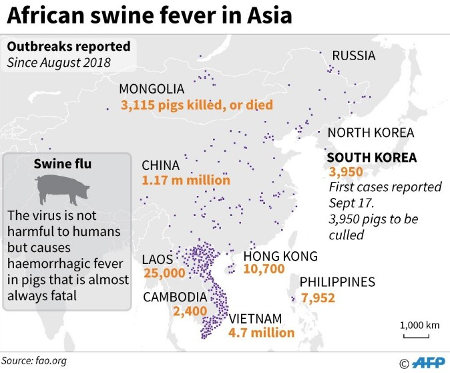South Korea on Tuesday reported its first cases of African swine fever, becoming the latest country hit by the disease that has killed pigs from China to North Korea, pushing up pork prices worldwide.
Five pigs found dead at a farm in Paju, a city near the inter-Korean border, were confirmed to have been infected with the virus, an official with Seoul's agriculture ministry told AFP.
"At this point, it's too early to confirm if the case stemmed from the North," the official added.
Seoul's agriculture minister Kim Hyun-soo said 3,950 pigs from three farms in Paju were to be culled.
The country has raised its animal disease alert to the highest level and a nationwide 48-hour ban on the movement of pigs was issued, he added.
The virus is not harmful to humans but causes haemorrhagic fever in pigs that is almost always fatal.
There is no antidote or vaccine and the only known way to prevent the disease from spreading is a mass cull of affected livestock.
Although this was the first confirmed outbreak of African swine fever in the South, the country has battled a number of animal diseases in the past.
In 2014, outbreaks of avian flu in poultry farms resulted in the culling of more than 500,000 birds.
A 2011 outbreak of foot-and-mouth disease resulted in the culling of nearly 3.5 million cattle, pigs and other animals.

Click here to see more...